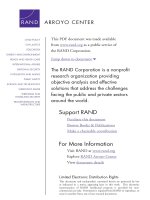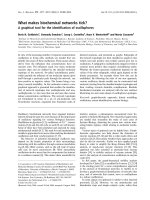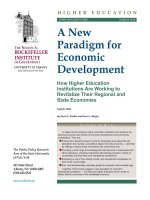Lean lexicon a graphical glossary for lean thinkers
Bạn đang xem bản rút gọn của tài liệu. Xem và tải ngay bản đầy đủ của tài liệu tại đây (22.21 MB, 136 trang )
d n
te tio
da di
Up rth E
u
Fo
Lean
Lexicon
a graphical glossary
for Lean Thinkers
Fourth Edition
Compiled by the Lean Enterprise Institute
Tai Lieu Chat Luong
Yokoten
115
115
Lean Lexicon
a graphical glossary
for Lean Thinkers
Compiled by the Lean Enterprise Institute
Edited by Chet Marchwinski, John Shook, and Alexis Schroeder
Foreword by Jose Ferro, Dan Jones, and Jim Womack
The Lean Enterprise Institute
Cambridge, MA, USA
lean.org
Fourth Edition, Version 4.0
March 2008
With gratitude to Michael Brassard, Pascal Dennis, Dave Logozzo,
Robert Martichenko, Rachel Regan, Thomas Skehan, Art Smalley,
Durward Sobek, Tonya Vinas, Jim Womack, and Helen Zak for their
close review of the manuscript. The root cause of all remaining errors
resides with the LEI editors.
© Copyright 2008 The Lean Enterprise Institute, Inc.
One Cambridge Center, Cambridge, MA 02142 USA
Tel: 617-871-2900 • Fax: 617-871-2999 • lean.org
ISBN 0-9667843-6-7
All Rights Reserved.
Design by Off-Piste Design, Inc.
Printed in the USA
Fourth Edition, Version 4.0, March 2008
Contents
Foreword
by Jose Ferro, Dan Jones, and Jim Womack
Introduction
by Chet Marchwinski and John Shook
Lean Terms: A to Z
Appendix A: Value-Stream Mapping Icons
Appendix B: Lean Acronyms
Appendix C: Lean Japanese and German Terms
Appendix D: Pronunciation Guide to Japanese Words
Appendix E: Cited Works
Foreword
We receive many inquiries from members of the Lean Community
asking for definitions of the terms we commonly use, ranging from
A3 report to yokoten. In addition, as we attend events and visit
companies we frequently find widespread confusion and inconsistent
use of terms as simple and fundamental as takt time. (It’s often still
confused with cycle time.)
Chet Marchwinski, LEI’s director of communications, and John
Shook, an LEI senior advisor, have responded for several years now
by clarifying many matters of terminology in response to individual
requests and by placing these clarifications on the Community Page
of the LEI web site. However, many Lean Thinkers continue to ask
the meaning of lean terms and we have decided that the best course
is simply to write them all down in one place in this Lean Lexicon.
We have asked Chet and John, as veterans of the lean movement
with broad knowledge of lean terminology at Toyota and elsewhere,
to tackle this task.
Lexicon is just a fancy word for dictionary—one that conveniently
alliterates with “lean”—and like all dictionaries, there is a need for
upgrades as usage changes and new terms emerge. This is therefore
Version 4.0 of what we imagine will be a continuing effort to define
and sharpen our language as we all move toward future states and
ideal states. In this spirit, we hope to hear from Lean Community
members about additional terms to include in future versions and
about changing usage and changing business needs that may call
for revised definitions and additional examples.
As most Lean Thinkers know, precision is the key to lean performance:
A precise plan for every part. Precisely determined standardized work.
Precise takt image visible to everyone in a production process. Precise
calculation of standard inventory at every point inventories still are
needed. But to achieve precision on the gemba (see the definition on
page 25) we require precision in our language. The Lean Lexicon is
our effort to precisely meet this critical need.
Jose Ferro, Dan Jones, and Jim Womack
Sao Paulo, SP, Brazil
Ross-on-Wye, Herefordshire, UK
Cambridge, MA, USA
Introduction
Drawing up a comprehensive list of lean terms is not an easy task.
Many members of the Lean Community have gained their knowledge
from different sources and use terms in slightly different ways. And
many companies have developed their own “lean lingo” in an effort
to customize usage to their needs and to make their production
system unique. We therefore have devised two simple principles for
selecting terms. These are:
1. The term is important.
You really need it to successfully operate a lean system.
2. The term is in widespread use.
It’s not just “company speak,” but lives in the broader community.
We also have needed to develop a common approach to definitions.
As shown on the sample page at right, for each term we provide:
A simple definition. An example, often showing different types
of applications. Cross-references to related terms. An illustration,
whenever possible. Of course, many terms, like chief engineer and
greenfield, would be impossible to illustrate beyond photos of specific
individuals and facilities!
As editors, we are acutely aware that there will be some differences
within the Lean Community on definitions, and we have tried to
provide the most common usage. We are even more aware that
some important terms may have been left out. We therefore hope
to hear suggestions for additions and improvements (which should
be sent to: ). We will issue revisions of the
Lean Lexicon as appropriate.
Chet Marchwinski, John Shook, and Alexis Schroeder
Bethel, CT, USA
Ann Arbor, MI, USA
Somerville, MA, USA
Andon
Term
Andon
A visual management tool that highlights the status of the operations
in an area at a single glance and that signals whenever an
abnormality occurs.
Definition
An andon can indicate production status (for example, which
machines are operating), an abnormality (for example, machine
downtime, a quality problem, tooling faults, operator delays, and
materials shortages), and needed actions, such as changeovers.
An andon also can be used to display the status of production in
terms of the number of units planned versus actual output.
Example
A typical andon, which is the Japanese term for “lamp,” is an
overhead signboard with rows of numbers corresponding to
workstations or machines. A number lights when a problem is
detected by a machine sensor, which automatically trips the
appropriate light, or by an operator who pulls a cord or pushes
a button. The illuminated number summons a quick response
from the team leader. Colored lighting on top of machines to
signal problems (red) or normal operations (green) is another
type of andon.
Crossreference
See: Jidoka, Visual Management.
Product
A
Illustration
Product
B
Simple andon.
1
2
3
4
1
2
3
4
Planned Production
Actual Production
110
98
Complex andon.
3
Fourth Edition Highlights
• Dashboard
• LAMDA Cycle
• Lean Product and Process Development
• Trade-off Curves
• True North
• Useable Knowledge
Treatment of Foreign Terms
Our editorial North Star, The Chicago Manual of Style,
states that foreign words usually are set in italics if they are
likely to be unfamiliar to readers. And in many works on
lean production and lean thinking terms such as kaizen and
muda are italicized. However, in preparing this lexicon, our
objective is to bring all of these terms into common usage.
Plus, we have no way to know which terms are now familiar
and which are still novel across the Lean Community.
We therefore have decided to welcome the entire list of terms
into the English language and have set all of them in plain
type. To avoid any confusion, we have included a list of all
foreign words in Appendix C so readers may be sure of each
term’s point of origin.
A Toyota-pioneered practice of getting the problem, the analysis,
the corrective actions, and the action plan down on a single sheet
of large (A3) paper, often with the use of graphics. At Toyota, A3
reports have evolved into a standard method for summarizing
problem-solving exercises, status reports, and planning exercises
like value-stream mapping.
A3 Report
A3 Report
A3 paper is the international term for paper 297 millimeters wide and
420 millimeters long. The closest U.S. paper size is the 11-by-17 inch
tabloid sheet.
See: Value-Stream Mapping (VSM).
1
A-B Control
A-B Control
A way to regulate the working relationships between two machines
or operations to control overproduction and ensure balanced use
of resources.
In the Illustration, neither of the machines nor the conveyor will cycle
unless three conditions are met: Machine A is full, the conveyor
contains the standard amount of work-in-process (in this case, one
piece), and Machine B is empty. When those conditions are met,
all three will cycle once and wait until the conditions are met again.
See: Inventory, Overproduction.
Signal
ABC Production Analysis
Segmenting part numbers into groups based on demand. Lean
Thinkers use this analysis to decide how much and for which
products to hold inventory. A items are high runners, B items are
medium runners, and C items are low runners. C items typically
include infrequent color and build combinations, special-edition
items, and replacement parts.
See: Flow Production, Pull Production.
2
Andon
Andon
A visual management tool that highlights the status of operations
in an area at a single glance and that signals whenever an
abnormality occurs.
An andon can indicate production status (for example, which
machines are operating), an abnormality (for example, machine
downtime, a quality problem, tooling faults, operator delays, and
materials shortages), and needed actions, such as changeovers.
An andon also can be used to display the status of production in
terms of the number of units planned versus actual output.
A typical andon, which is the Japanese term for “lamp,” is an
overhead signboard with rows of numbers corresponding to
work- stations or machines. A number lights when a problem
is detected by a machine sensor, which automatically trips the
appropriate light, or by an operator who pulls a cord or pushes
a button. The illuminated number summons a quick response
from the team leader. Colored lighting on top of machines to
signal problems (red) or normal operations (green) is another
type of andon.
See: Jidoka, Visual Management.
Product
A
Product
B
Simple andon.
1
2
3
4
1
2
3
4
Planned Production
Actual Production
110
98
Complex andon.
3
Automatic Line Stop
Automatic Line Stop
Ensuring that a production process stops whenever a problem
or defect occurs.
For an automated line this usually involves the installation of sensors
and switches that automatically stop the line when an abnormality
is detected. For a manual line a fixed-position stop system often is
installed. This permits operators to pull an overhead cord or push
a button that stops the process at the end of a work cycle if the
problem encountered cannot be fixed during the cycle.
These examples illustrate the lean principle of jidoka, which prevents
defects from going to the next phase of production and avoids the
waste of making a series of defective items. Mass producers, by
contrast, will try to keep lines running to achieve high equipment
utilization, even when known defects occur repetitively and require
rework at the end of the process.
See: Error-Proofing, Fixed-Position Stop System, Jidoka.
Automatic line stop.
Autonomation
See: Jidoka.
4
A mass production approach to operations in which large lots
(batches) of items are processed and moved to the next process
—regardless of whether they are actually needed—where they
wait in a line (a queue).
Build-to-Order
Batch-and-Queue
See: Continuous Flow, Lean Production, Overproduction,
Push Production.
Batch-and-queue production.
Brownfield
An existing production facility, usually managed in accordance with
mass production thinking.
Compare: Greenfield.
Buffer Stock
See: Inventory.
Building in Quality, Built-in Quality
See: Jidoka.
Build-to-Order
A situation in which production lead time and order lead time are
less than the time the customer is prepared to wait for the product,
and the producer builds products entirely to confirmed order rather
than to forecast.
5
Build-to-Order
This is a condition Lean Thinkers strive to achieve because it avoids
the demand amplification and waste inherently involved in building
products based on informed guesses about customer desires.
See: Demand Amplification, Heijunka, Level Selling.
Capital Linearity
A philosophy for designing and buying production machinery so
that small amounts of capacity can be added or subtracted as
demand changes. In this way, the amount of capital needed per
part produced can be very nearly level (linear).
For example, in capacitizing for 100,000 units of annual output, a
manufacturer might purchase a series of machines, each with an
annual capacity of 100,000 units, and link them in one continuous
flow production line (first alternative). Alternatively, the manufacturer
might buy 10 sets of smaller machines to install in 10 cells, with each
cell having annual capacity of 10,000 units (second alternative).
If the forecast of 100,000 units proved to be exactly correct, the single
line with 100,000 units might be the most capital efficient. But if real
demand is different, the second alternative offers distinct advantages:
• Whenever demand goes beyond 100,000 units, the
manufacturer can add either another line with 100,000
units of capacity or just the required number of cells,
each with 10,000 units of capacity, to satisfy the higher
demand. By adding cells, the capital investment per unit
of output would vary only slightly with changing demand.
It would be very nearly linear.
Whenever the real demand is less than 100,000 units, a more serious
problem arises. The first alternative makes it almost impossible to
decrease capacity and maintain efficiency at the current level. However,
the second alternative allows the manufacturer to subtract capacity
by shutting down as many cells as required.
See: Labor Linearity, Monument, Right-Sized Tools.
Catchball
See: Policy Deployment.
6
Cell
Cell
The location of processing steps for a product immediately adjacent
to each other so that parts, documents, etc., can be processed in
very nearly continuous flow, either one at a time or in small batch
sizes that are maintained through the complete sequence of
processing steps.
A U shape (shown below) is common because it minimizes walking
distance and allows different combinations of work tasks for
operators. This is an important consideration in lean production
because the number of operators in a cell will change with changes
in demand. A U shape also facilitates performance of the first and
last steps in the process by the same operator, which is helpful in
maintaining work pace and smooth flow.
Many companies use the terms cell and line interchangeably.
Ass
em
bly
II
Fer
rul
Hos es
es
ses
T. Ho es
Valv
Assembly I
1
Crimper
Material
Flow
Connectors
Tube Bender
(automatic)
load 1 tube
at a time
out
2
load
Operator
Motion
Te
(au ster
tom
atic
)
Tubes
30 pcs./container
(finished goods)
Example of a U-shaped cell.
7
Cell
There is a school of thought that material should flow through cells
in a right-to-left direction relative to the operator, because more
people are right handed and it is more efficient and natural to work
from right to left. However, many efficient processes flow to the left
and many flow to the right. Simply evaluate on a case-by-case
basis whether a particular direction makes more sense.
See: Continuous Flow, Operator Balance Chart, Standardized Work.
Chaku-Chaku
A method of conducting one-piece flow in a cell where machines
unload parts automatically so that the operator (or operators) can
carry a part directly from one machine to the next without stopping
to unload the part, thus saving time and motion.
For instance, the first machine in a processing sequence automatically
ejects a part as soon as its cycle is completed. The operator takes the
part to the next machine in the sequence, which has just finished
cycling and ejected its part. The operator loads the new part, starts
the machine, and takes the ejected part to the next machine, which
has just finished cycling and ejected its part and so on around the
cell. The term literally means "load-load" in Japanese.
See: Cell, Continuous Flow.
Change Agent
The leader of a lean conversion who has the willpower and drive to
initiate fundamental change and make it stick.
The change agent—who often comes from outside the organization
—doesn’t need detailed lean knowledge at the beginning of the
conversion. The knowledge can come from a lean expert, but the
change agent absolutely needs the will to see that the knowledge
is applied and becomes the new way of working.
Compare: Sensei.
Changeover
The process of switching from the production of one product or
part number to another in a machine (e.g., a stamping press or
8
Chief Engineer
molding machine) or a series of linked machines (e.g., an assembly
line or cell) by changing parts, dies, molds, fixtures, etc. (Also called
a setup.) Changeover time is measured as the time elapsed between
the last piece in the run just completed and the first good piece from
the process after the changeover.
See: Single Minute Exchange of Die (SMED).
Chief Engineer
The term used at Toyota for the program manager with total
responsibility for the development of a product line; previously
known by the Japanese term shusa.
The chief engineer leads a small, dedicated team that creates the
product concept, develops the business case, leads the technical
design of the product, manages the development process, coordinates
with production engineering and sales/marketing, and takes the
product into production.
Chief engineers typically have strong technical skills that enable
them to effectively lead and coordinate the technical work of
engineers, designers, and other developers assigned to their
projects. Their most important responsibility is to integrate the
work of the development team around a coherent and compelling
vision for the product.
However, chief engineers do not directly supervise most of the
developers who work on their products. Most members of the
development team report to managers within their own functional
units (in Toyota’s case, body engineering, drive train engineering,
test engineering, purchasing, and so forth). The organizational
structure sets up a natural tension between the project leader (who
wants to realize his product vision) and the functional units (who
understand intimately what is possible).
This creative tension becomes a source of innovation as the project
leaders continually push the organization into new territory according
to market needs, even as the functional units try to keep the project
leaders true to the organization’s technological capabilities. Also
called an Entrepreneur System Designer or Deployment Leader.
See: Value-Stream Manager.
9
Continuous Flow
Continuous Flow
Producing and moving one item at a time (or a small and consistent
batch of items) through a series of processing steps as continuously
as possible, with each step making just what is requested by the
next step.
Continuous flow can be achieved in a number of ways, ranging from
moving assembly lines to manual cells. It also is called one-piece
flow, single-piece flow, and make one, move one.
See: Batch-and-Queue, Flow Production, One-Piece Flow.
Continuous flow processing.
Cross-Dock
A facility that sorts and recombines a variety of inbound items
from many suppliers for outbound shipment to many customers,
such as assembly plants, distributors, or retailers.
A common example is a facility operated by a manufacturer with
many plants in order to efficiently gather materials from many
suppliers. When a truck loaded with pallets of goods from suppliers
arrives on one side of the dock, the pallets are immediately unloaded,
and taken to several shipping lanes for loading onto outbound trucks
bound for different facilities (see illustration on p. 11).
A cross-dock is not a warehouse because it does not store goods.
Instead, goods are usually unloaded from inbound vehicles and
moved to shipping lanes for outbound vehicles in one step. If
outbound vehicles leave frequently, it may be possible to clear
the floor of the cross-dock every 24 hours.
10
Cycle Time
Example of a Cross-Dock
inbound
crossdock
outbound
Current-State Map
See: Value-Stream Mapping (VSM).
Cycle Time
The time required to produce a part or complete a process, as timed
by actual measurement.
Cycle Time—Related Terms Involving Time
Effective Machine Cycle Time
Machine cycle time plus load and unload time, plus the result of
dividing changeover time by the number of pieces between changeovers. For example, if a machine has a cycle time of 20 seconds, plus
a combined load and unload time of 30 seconds, and a changeover
time of 30 seconds divided by a minimum batch size of 30, the
Effective Machine Cycle Time is 20+30+(30/30) or 1 = 51 seconds.
Machine Cycle Time
The time a machine requires to complete all of its operations
on one piece.
11
Cycle Time
Nonvalue-Creating Time
The time spent on activities that add costs but no value to an item
from the customer’s perspective. Such activities typically include
storage, inspection, and rework.
Operator Cycle Time
The time it takes an operator to complete all the work elements at
a station before repeating them, as timed by direct observation.
Order Lead Time
Production lead time plus time expended downstream in getting
the product to the customer, including delays for processing orders
and entering them into production and delays when customer orders
exceed production capacity. In other words, the time the customer
must wait for the product.
Order-to-Cash Time
The amount of time that elapses from the receipt of a customer
order until the producer receives cash payment from the customer.
This can be more or less than order lead time, depending on
whether a producer is in a build-to-order or a ship-from-stock
mode, on terms of payment, etc.
Processing Time
The time a product actually is being worked on in design or production
and the time an order actually is being processed. Typically, processing
time is a small fraction of production lead time.
Production Lead Time (also Throughput Time and Total Product
Cycle Time)
The time required for a product to move all the way through a process
or a value stream from start to finish. At the plant level this often is
termed door-to-door time. The concept also can be applied to the
time required for a design to progress from start to finish in product
development or for a product to proceed from raw materials all the
way to the customer.
Value-Creating Time
The time of those work elements that actually transform the
product in a way that the customer is willing to pay for. Usually,
value-creating time is less than cycle time, which is less than
production lead time.
See: Value.
12
Cycle Time
Cycle Time
(CT)
Cycle Time (CT)
How often a part or product
actually is completed by a process,
as timed by observation. Also, the
time it takes an operator to go
through all work elements before
repeating them.
Value-Creating Time
Value-Creating Time (VCT)
Time of those work elements that
actually transform the product
in a way that the customer is
willing to pay for.
Production Lead Time
Production Lead Time (PLT)
The time it takes one piece to
move all the way through a
process or a value stream, from
start to finish. Envision timing a
marked part as it moves from
beginning to end.
or
Usually: VCT
< CT < PLT
13
Dashboard
Dashboard
A one-page measurement tool comprising the critical few end-of-pipe
(downstream) and process (upstream) measures related to a strategy
or action plan (see illustration on p. 15). It helps a leader check and
adjust a plan and provides real-time measures for real-time feedback.
Value-stream maps and dashboards are complementary tools:
Maps raise critical questions to be addressed during the plan
phase of the plan-do-check-act cycle. Dashboards raise questions
for leaders to address during the check and act phases. (Adapted
from Dennis 2006, p. 62.)
See: Plan, Do, Check, Act (PDCA), Value-Stream Mapping
Demand Amplification
The tendency in any multistage process for production orders
received by each upstream process to be more erratic than actual
production or sales at the next downstream process. This also is
called the Forrester Effect (after Jay Forrester at MIT who first
characterized this phenomenon mathematically in the 1950s) and
the Bullwhip Effect.
The two main causes of demand amplification as orders move
upstream are: (a) The number of decision points where orders can
be adjusted; and (b) delays while orders wait to be processed and
passed on (such as waiting for the weekly run of the Material
Requirements Planning system). The longer the delays, the greater
the amplification as more production is determined by forecasts
(which become less accurate the longer the forecasting horizon)
and as more adjustments are made to the orders (by system
algorithms adding “just-in-case” amounts).
Lean Thinkers strive to use leveled pull systems with frequent
withdrawals for production and shipping instructions at each stage
of the value stream in order to minimize demand amplification.
The demand amplification chart on p. 16 shows a typical situation
in which the variation in demand at the customer end of the value
stream (Alpha) is modest, about +/-3% during a month. But as
orders travel back up the value stream through Beta and Gamma
they become very erratic until Gamma’s orders sent to its raw
materials supplier vary by +/-35% during a month.
14
Dashboard
Example of a dashboard.
15









